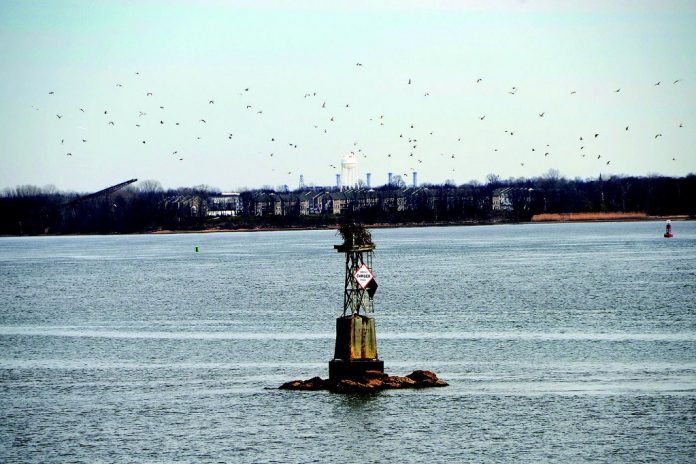Restoring roots: Friends of Poquessing members say volunteers are needed on April 27 to help remove invasive species from along the Glen Foerd Estate creek banks, to restore the view and bring back native plant life. Pictured, an osprey builds its nest on
Had Charles Macalester happened upon the confluence of the Poquessing Creek and Delaware River today, he might’ve built a Japanese yashiki there instead of a grand Victorian mansion, such is the dominance of bamboo on the present-day Glen Foerd Estate.
The towering plants are native to the Far East, but have managed to invade and take over much of the city-owned park and historical site, obscuring views of the creek and the river, while choking out many of the native flora that likely influenced Macalester’s decision to build his home there some 160 years ago.
Fortunately for folks who now enjoy the mansion and surrounding acreage due to the stewardship of the Glen Foerd Conservation Corporation, the bamboo wasn’t there when Macalester showed up. So he built his mansion in period-appropriate style. It was only later, according to the estate’s executive director, Meg Sharp Walton, that he or his successors introduced the resilient, fast-growing woody grass, among many other non-native plants, to the site.
The family of Robert Foerderer occupied the estate for most of the 20th century and, like many well-to-do clans of the time, planted many exotic foreign species as a show of opulence. Today, they are considered a nuisance.
“Ever since we’ve been partnering with the Friends of Poquessing Watershed, we’ve talked about how we could educate people about the creek,” Sharp Walton said. “It’s really, really beautiful here, but because of the invasives, you get no sense that Glen Foerd borders on the creek.”
Now, the creek’s and the estate’s caretakers have begun the prodigious task of clearing the invasive plants and trying to revive the native ones. The Pennsylvania Environmental Council also supports the effort.
Volunteers plan to remove unwanted plants and litter from the creek bank on April 27. The public is invited to take part. In fact, a weekend of environmental programming will start on Friday, April 26, when Philadelphia waterway historian Adam Levine will speak about the city’s watersheds and sewer system at 7 p.m. at Holy Family University’s Education and Technology Center. Admission is free.
Glen Foerd will host a bird walk at 7 a.m. on Saturday. It’s free to members of the historical site and costs $3 for non-members. The Poquessing clean-up event will start at 9 a.m. and is free.
“In a nutshell, we want to replace what shouldn’t be here with native plantings,” said Suzanne Zlotnick, vice president of education for the Friends of Poquessing. “We want to restore the stream bank to the way it should be without species that don’t belong in Pennsylvania. We want this to have native plantings as it should be historically and naturally.”
Robin Eisman, a Friends of Poquessing member and Ph.D. specializing in ecological restoration, can name many of the non-native trees, shrubs, vines and grasses on sight. The princess tree or paulownia is native to China and is banned in Connecticut, but is sold openly online, she said. Wineberry is also native to the Far East and banned in a couple of U.S. states. Other non-native plants include English ivy, Norway maple and Japanese honeysuckle.
The justification for removing them is both visual and ecological.
“Environmentally, because all of the [local] wildlife has evolved with the native plants, these [invasive plants] have taken away food sources from the habitat,” Eisman said. “It affects the mammals, the birds, the amphibians and reptiles in this area in general.”
Bamboo is enemy №1. What began perhaps as a single row of low, ornamental plants along the sloping banks of the river and its tributary is now a thicket, some 10 feet deep and at least that tall. In addition to obscuring many of the estate’s natural vistas, it blocks walkways once used by the home’s affluent residents to stroll along the water.
“[Bamboo] was very popular with wealthy industrialists” in the early 20th century, Sharp Walton said. “[But] it has taken over and it will continue to do so. We constantly have to clear it and it encroaches onto the pathway.”
For birders, the bamboo also obscures a rare family of ospreys that began nesting atop a river buoy more than a decade ago and that return each spring. Cindy Ferguson, director of operations for the Pennsylvania Environmental Council and a resident of nearby Salem Harbor, says that an adult female osprey positioned herself low in the nest about 10 days ago and may already be incubating a new set of eggs.
Ironically, other birds also are to blame for the spread of invasive plants, as is the life-giving water that flows alongside the estate. According to Eisman, birds and water carry seeds long distances and can deposit them where they were never intended to flourish.
For Sharp Walton, the project must meet the environmental needs of the site while staying true to her organization’s historical mission.
“The caveat for Glen Foerd is preserving the historical landscape,” Sharp Walton said. “The Macalasters were big on trees and the Foerderers were horticulturists. [But] with the banks, the first issue is the ecosystem.”
For information about Glen Foerd on the Delaware, visit www.glenfoerd.org or call 215–632–5330. ••
Reporter William Kenny can be reached at 215–354–3031 or [email protected]





